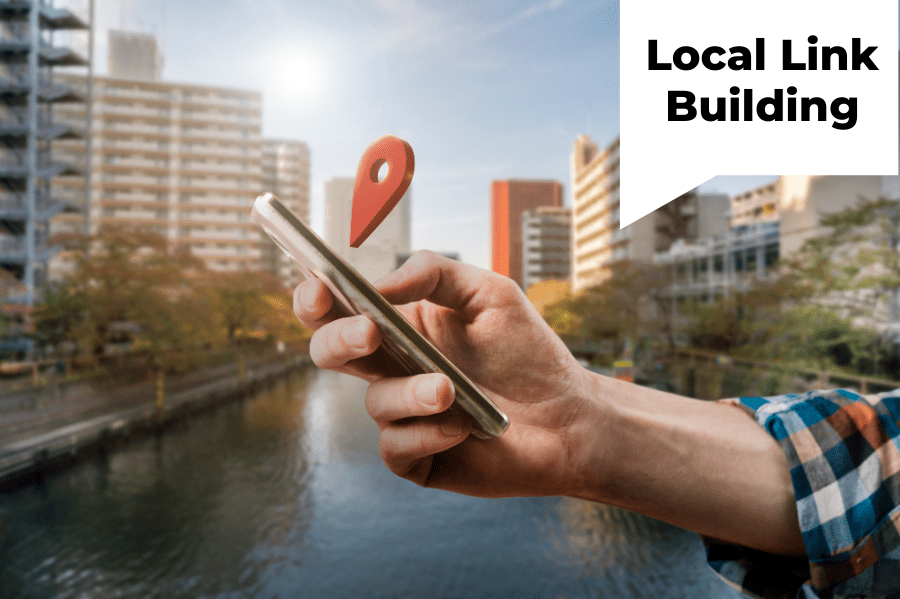In today’s digital landscape, local businesses face fierce competition to stand out in search engine results. Local link building is one of the most effective ways to improve your local search visibility. This comprehensive guide will walk you through the ins and outs of local link building, providing you with actionable strategies to boost your local SEO efforts and outrank your competitors.
Understanding Local Link Building
Local link building is the process of acquiring backlinks from websites that are relevant to your local area or industry. These links serve as “votes of confidence” for your business in search engines’ eyes, helping improve your local search rankings and visibility.
What Makes a Link “Local”?
A local link typically comes from:
- Websites based in your geographic area
- Industry-specific sites relevant to your business
- Local directories and citation sources
- Community organizations and events
- Local news outlets and publications
The Importance of Local Links for SEO
Local links are crucial to your overall SEO strategy, particularly for businesses targeting a specific geographic area. Here’s why they matter:
- Improved Local Search Rankings: Local links help search engines understand your business’s relevance to specific locations, boosting your chances of appearing in local search results and map packs.
- Increased Domain Authority: High-quality local links can improve your website’s overall domain authority, making it easier to rank for competitive keywords.
- Targeted Traffic: Links from local sources often bring in more relevant traffic, as visitors are more likely to be interested in your products or services.
- Brand Awareness: Local link building often involves community engagement, which can increase brand awareness and recognition in your target market.
- Trust and Credibility: Links from reputable local sources can enhance your business’s credibility in the eyes of both search engines and potential customers.
How Many Local Links Do You Need?
The number of local links needed to see significant improvements in your search rankings can vary depending on your industry and competition. However, research suggests that most local businesses don’t need an overwhelming number of links to rank well in local search results.
According to data from Ahrefs, businesses ranking on the first page for local queries typically have fewer than 150 referring domains. This indicates that quality often trumps quantity when it comes to local link building.
To determine your link building goals:
- Analyze your top competitors using tools like Ahrefs or Moz
- Look at the number and quality of their backlinks
- Set realistic goals based on this competitive analysis
- Focus on acquiring high-quality, relevant local links rather than sheer numbers
15 Effective Local Link Building Strategies
Now that we understand the importance of local links, let’s dive into 15 proven strategies to build a strong local link profile:
1. Leverage Local Directories and Citations
Local directories and citation sites are excellent sources for building your initial link profile. Some key platforms to target include:
- Google Business Profile
- Yelp
- Yellow Pages
- Better Business Bureau
- Industry-specific directories
Pro Tip: Ensure your business information (NAP – Name, Address, Phone number) is consistent across all listings to maximize their SEO value.
2. Create and Optimize Location-Specific Pages
If your business serves multiple locations, create dedicated pages for each area. These pages can attract location-specific links and improve your chances of ranking in local search results.
3. Engage with Local Community Events
Participate in or sponsor local events to gain exposure and potential backlinks. Look for opportunities such as:
- Charity events
- Local festivals
- Sports tournaments
- Business expos
4. Collaborate with Local Influencers and Bloggers
Partner with local influencers or bloggers in your industry to create content, offer guest posts, or secure product reviews. This can lead to valuable backlinks and increased local visibility.
5. Utilize Local PR and News Outlets
Submit press releases about newsworthy events, such as:
- New product launches
- Company milestones
- Community initiatives
- Expert commentary on local issues
6. Create Locally-Relevant Content
Develop content that appeals to your local audience, such as:
- Local guides and resources
- Area-specific case studies
- “Best of” lists for local businesses or attractions
7. Offer Scholarships or Internships
Create scholarship programs or internship opportunities for local students. Educational institutions often link to these programs, providing high-quality backlinks.
8. Join Local Business Associations
Become a member of local chambers of commerce, business improvement districts, or industry associations. These organizations often provide member directories with valuable links.
9. Leverage Relationships with Suppliers and Partners
Reach out to your local suppliers, vendors, or business partners for potential link opportunities, such as:
- Customer spotlights
- Testimonials
- Case studies
10. Reclaim Lost or Unlinked Mentions
Use tools like Google Alerts or Ahrefs to find mentions of your business that don’t include a link. Reach out to these websites and request that they add a link to your site.
11. Create a Local Resource Center
Develop a comprehensive resource center on your website with information valuable to your local community. This can attract links from other local businesses and organizations.
12. Sponsor Local Sports Teams or Athletes
Support local sports teams or individual athletes. This often leads to backlinks from team websites, local sports news, and community pages.
13. Host or Speak at Local Events
Organize workshops, seminars, or networking events in your area. Alternatively, offer to speak at existing local events to gain exposure and potential backlinks from event pages.
14. Implement a Local Link Intersect Strategy
Use tools like Ahrefs’ Link Intersect feature to find websites linking to your local competitors but not to you. Reach out to these sites and explore link opportunities.
15. Leverage Local Social Media Groups
Join and actively participate in local Facebook groups, LinkedIn groups, or subreddits related to your industry or area. Share valuable content and engage with the community to build relationships that may lead to natural link opportunities.
Best Practices for Local Link Building
To maximize the effectiveness of your local link building efforts, follow these best practices:
- Focus on Quality Over Quantity: Prioritize links from reputable, locally-relevant sources rather than pursuing a high volume of low-quality links.
- Diversify Your Link Profile: Aim for a mix of different types of links, including citations, editorial links, and user-generated content.
- Keep It Natural: Avoid over-optimizing anchor text or acquiring links too quickly, as this can raise red flags with search engines.
- Build Genuine Relationships: Focus on creating valuable partnerships and connections within your local community rather than solely pursuing links.
- Stay Consistent with NAP Information: Ensure your business name, address, and phone number are consistent across all online mentions and citations.
- Monitor Your Backlink Profile: Regularly audit your backlink profile to identify and disavow any potentially harmful links.
- Combine Link Building with Other Local SEO Efforts: Integrate your link building strategy with other local SEO tactics, such as on-page optimization and review management.
Measuring the Success of Your Local Link-Building Efforts
To ensure your local link-building strategy is effective, track these key performance indicators (KPIs):
- Increase in Referring Domains: Monitor the growth of unique websites linking to your site.
- Improvement in Local Search Rankings: Track your rankings for target keywords in local search results and map packs.
- Growth in Organic Traffic: Measure the increase in organic traffic, particularly from users in your target locations.
- Citation Flow and Trust Flow: Use tools like Majestic to monitor improvements in these metrics, which indicate the quality and trustworthiness of your backlink profile.
- Domain Authority and Page Authority: Track changes in these metrics using tools like Moz to gauge your website’s overall SEO health.
- Local Visibility Score: Use tools like BrightLocal to measure your overall local search visibility.
- Conversion Rate from Local Traffic: Monitor how well your local traffic is converting into leads or customers.
Common Pitfalls to Avoid in Local Link Building
While building local links, be cautious of these common mistakes:
- Purchasing Links: Buying links violates Google’s guidelines and can result in penalties.
- Neglecting Link Quality: Focusing solely on quantity without considering the relevance and authority of linking sites.
- Over-optimizing Anchor Text: Using exact-match keywords too frequently in anchor text can appear unnatural.
- Ignoring Relevance: Pursuing links from sources that aren’t relevant to your local area or industry.
- Failing to Diversify: Relying too heavily on one type of link, such as directory listings.
- Neglecting On-Page SEO: Focusing on link building without optimizing your website’s content and structure.
- Inconsistent NAP Information: Having conflicting business information across different citations and mentions.
Future Trends in Local Link Building
As search engines and user behaviors evolve, so too will local link building strategies. Here are some trends to watch for:
- Emphasis on User-Generated Content: Encouraging customers to create content that naturally links back to your business.
- Voice Search Optimization: Adapting link-building strategies to target voice search queries, which often have local intent.
- Hyperlocal Content: Creating extremely localized content to attract links from niche community sources.
- Integration with Social Signals: As search engines potentially give more weight to social signals, local businesses may focus on building “social links” through platforms like Facebook and Instagram.
- AI-Powered Link Building: Utilizing artificial intelligence to identify high-quality link opportunities and automate link-building outreach processes.
- Mobile-First Link Building: Prioritizing links from mobile-friendly websites as mobile usage continues to dominate local searches.
- Video Content for Link Attraction: Creating locally relevant video content to attract links from video platforms and local media outlets.
Conclusion
Local link building is a powerful strategy for improving your business’s visibility in local search results. By focusing on acquiring high-quality, relevant links from local sources, you can boost your SEO efforts and outrank your competitors.
Remember that successful local link building is an ongoing process that requires patience, creativity, and consistent effort. By implementing the strategies outlined in this guide and staying up-to-date with emerging trends, you’ll be well-positioned to dominate local search results and attract more customers to your business.
Start building your local link profile today, and watch your local SEO performance soar!






